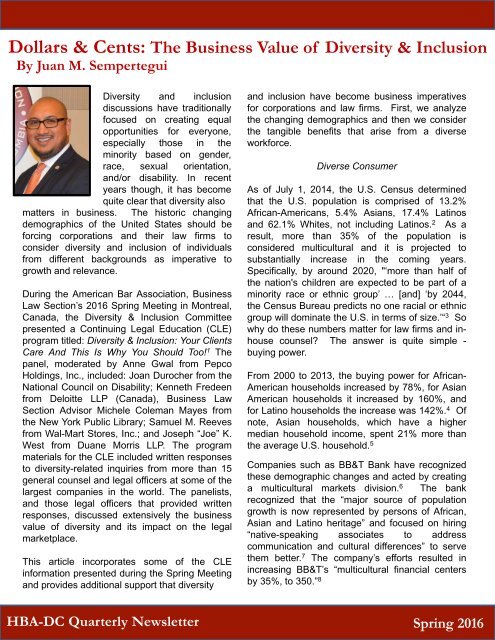Hispanic Bar Association of DC
HBA-DC_Quarterly_2016.02_Spr
HBA-DC_Quarterly_2016.02_Spr
Create successful ePaper yourself
Turn your PDF publications into a flip-book with our unique Google optimized e-Paper software.
Dollars & Cents: The Business Value <strong>of</strong> Diversity & Inclusion<br />
By Juan M. Sempertegui<br />
Diversity and inclusion<br />
discussions have traditionally<br />
focused on creating equal<br />
opportunities for everyone,<br />
especially those in the<br />
minority based on gender,<br />
race, sexual orientation,<br />
and/or disability. In recent<br />
years though, it has become<br />
quite clear that diversity also<br />
matters in business. The historic changing<br />
demographics <strong>of</strong> the United States should be<br />
forcing corporations and their law firms to<br />
consider diversity and inclusion <strong>of</strong> individuals<br />
from different backgrounds as imperative to<br />
growth and relevance.<br />
During the American <strong>Bar</strong> <strong>Association</strong>, Business<br />
Law Section’s 2016 Spring Meeting in Montreal,<br />
Canada, the Diversity & Inclusion Committee<br />
presented a Continuing Legal Education (CLE)<br />
program titled: Diversity & Inclusion: Your Clients<br />
Care And This Is Why You Should Too! 1 The<br />
panel, moderated by Anne Gwal from Pepco<br />
Holdings, Inc., included: Joan Durocher from the<br />
National Council on Disability; Kenneth Fredeen<br />
from Deloitte LLP (Canada), Business Law<br />
Section Advisor Michele Coleman Mayes from<br />
the New York Public Library; Samuel M. Reeves<br />
from Wal-Mart Stores, Inc.; and Joseph “Joe” K.<br />
West from Duane Morris LLP. The program<br />
materials for the CLE included written responses<br />
to diversity-related inquiries from more than 15<br />
general counsel and legal <strong>of</strong>ficers at some <strong>of</strong> the<br />
largest companies in the world. The panelists,<br />
and those legal <strong>of</strong>ficers that provided written<br />
responses, discussed extensively the business<br />
value <strong>of</strong> diversity and its impact on the legal<br />
marketplace.<br />
This article incorporates some <strong>of</strong> the CLE<br />
information presented during the Spring Meeting<br />
and provides additional support that diversity<br />
and inclusion have become business imperatives<br />
for corporations and law firms. First, we analyze<br />
the changing demographics and then we consider<br />
the tangible benefits that arise from a diverse<br />
workforce.<br />
Diverse Consumer<br />
As <strong>of</strong> July 1, 2014, the U.S. Census determined<br />
that the U.S. population is comprised <strong>of</strong> 13.2%<br />
African-Americans, 5.4% Asians, 17.4% Latinos<br />
and 62.1% Whites, not including Latinos. 2 As a<br />
result, more than 35% <strong>of</strong> the population is<br />
considered multicultural and it is projected to<br />
substantially increase in the coming years.<br />
Specifically, by around 2020, "‘more than half <strong>of</strong><br />
the nation's children are expected to be part <strong>of</strong> a<br />
minority race or ethnic group’ … [and] ‘by 2044,<br />
the Census Bureau predicts no one racial or ethnic<br />
group will dominate the U.S. in terms <strong>of</strong> size.’“ 3 So<br />
why do these numbers matter for law firms and inhouse<br />
counsel? The answer is quite simple -<br />
buying power.<br />
From 2000 to 2013, the buying power for African-<br />
American households increased by 78%, for Asian<br />
American households it increased by 160%, and<br />
for Latino households the increase was 142%. 4 Of<br />
note, Asian households, which have a higher<br />
median household income, spent 21% more than<br />
the average U.S. household. 5<br />
Companies such as BB&T Bank have recognized<br />
these demographic changes and acted by creating<br />
a multicultural markets division. 6 The bank<br />
recognized that the “major source <strong>of</strong> population<br />
growth is now represented by persons <strong>of</strong> African,<br />
Asian and Latino heritage” and focused on hiring<br />
“native-speaking associates to address<br />
communication and cultural differences” to serve<br />
them better. 7 The company’s efforts resulted in<br />
increasing BB&T’s “multicultural financial centers<br />
by 35%, to 350.” 8<br />
HBA-<strong>DC</strong> Quarterly Newsletter Spring 2016


